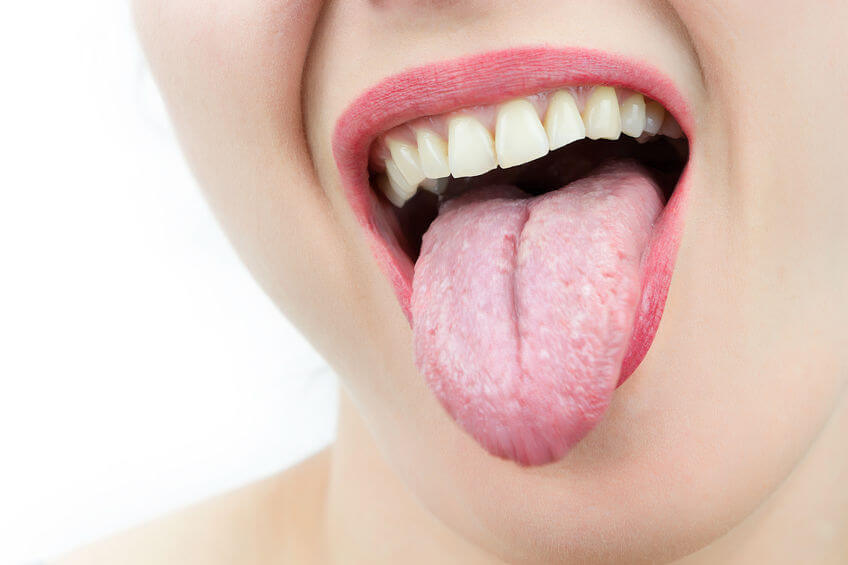Author: Lizzie Smith – blog last updated on Thursday 6th July
Do you suffer from a white or yellowish deposit on your tongue? If you do, you’ll probably want to get rid of it quickly because deposits on your tongue not only reduce your oral health, but they don’t exactly make your breath fresher either. And it doesn’t look too great!
The good news is that having these nasty deposits on your tongue doesn’t usually indicate disease, and you can get rid of them really easily.
What is white plaque on the tongue?
The white or yellowish coating on your tongue is a mixture of saliva, food debris and bacteria. It’s similar to dental plaque but on your tongue.
You should remove plaque twice a day to prevent tartar. However, plaque on your tongue can’t become tartar, but it can cause mouth problems such as bad breath.
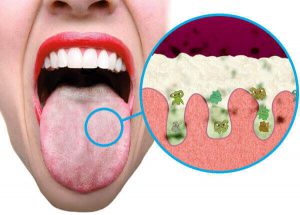
As with dental plaque, the harmful anaerobic bacteria convert sugars into sulfur compounds, which causes bad breath. If it goes unnoticed, the soft tissues, especially at the back of the tongue, can become a hotbed of bacteria.
If the white deposit on the tongue thickens, you can even get a bad taste in your mouth, often described as metallic or bitter. When this happens, it’s high time to intervene.
A bad taste in your mouth isn’t pleasant, and it also hinders your ability to taste other flavours. In addition, other people can sometimes smell it. Whilst a bad taste in your mouth doesn’t always go hand in hand with bad breath, it’s still prudent to clean your tongue if you suffer from one or both of these symptoms.
How did you get a white tongue attack?
Several different factors contribute to this unsavoury white coating on your tongue. The following are the most important:
- Deficient oral hygiene. If you don’t brush your teeth carefully twice a day for two minutes and clean the interdental spaces with dental floss or dental brushes, the harmful bacterial colony will grow in your mouth. They settle in the most accessible places – on the border of teeth and gums, between your teeth and in the tongue tissue. The excess of this harmful anaerobic bacteria disturbs the balance of the oral flora.
- Aggressive ingredients in oral care products. If your daily oral hygiene is basically okay, but you use the wrong toothpaste and mouthwash, the balance in the oral cavity can also be disturbed. Antiseptics such as alcohol and triclosan not only contain harmful bacteria but also beneficial ones. All kinds of nasty chemicals, such as SLS ( sodium lauryl sulfate ) and artificial colours and flavours, are added to many toothpastes and mouthwashes. In addition, acidity in the mouth is essential for a healthy balance of the oral flora. So, you should avoid care products that contain acidifying ingredients and instead opt for mouth-friendly products that neutralise acidity. Examples are toothpaste and mouthwash from JuliBrite and Rytt Pro.
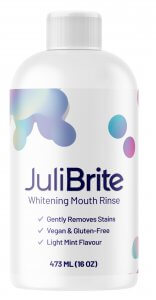
- Dry mouth complaints. If, for whatever reason, you don’t have enough saliva in your mouth, you run a higher risk of white or yellow deposits on the tongue. Saliva acts as a natural protection for your teeth and oral cavity. So, if there’s too little of it, it directly affects the oral flora and your oral health in general. The mouth acidifies faster, and a lack of saliva causes an increase in the harmful bacteria that are responsible for white tongue deposits.
- Roughness of the tongue. In addition to the above factors, it makes sense that the rougher your tongue is, the more bacteria and food debris can stick to it. For most people, the back of the tongue, in particular, has a very rough texture.
- Lifestyle-related factors. It’s well known that a healthy lifestyle with a varied diet, sufficient exercise and rest is vital for your general health. Your lifestyle also significantly influences your oral health and whether or not white tongue deposits occur. Things like smoking, drinking a lot of alcohol, stress and unhealthy eating promote the cultivation of harmful bacteria, which thus increases the chance of a dirty white tongue.
- Diseases. In most cases, white or yellow deposits are a matter of a disturbed bacterial balance in the mouth. This is harmless and can be remedied with a few simple interventions. Occasionally, however, a white tongue can be the signal of an infection or other condition that’s disrupting your oral health. In the event of a cold, flu or laryngitis, the oral flora can also be disrupted to such an extent that you get a white tongue. Fortunately, this is only temporary, although paying attention to it is good. And then there are the specific tongue diseases, where there are other symptoms besides the white or yellowish deposit. Think of blisters, a feeling of burning and other coloured deposits. Diseases that can alter the tongue’s appearance include leukoplakia, oral lichen planus, cancer of the mouth or tongue, and syphilis. The proliferation of Candida albicans (also called oral fungal infection) often occurs after a course of antibiotics and can also give the tongue a white appearance.
How do you get that nasty white coating off your tongue?
Usually, a white deposit on the tongue is harmless, and you can quickly get rid of a bad taste in your mouth and/or bad breath. But if it’s bothering you, you start to prevent it by cleaning your tongue daily.
First of all, don’t use your toothbrush. It may seem convenient, but it’s not. The bristles on your toothbrush are meant to remove plaque from your tooth enamel, which is hard and slippery. In contrast, your tongue is made up of soft and rough tissue, which is very different from tooth enamel and requires a different treatment. In addition, the head of your toothbrush is too high, and you won’t be able to reach the back of your tongue without gagging.
To clean your tongue, you should use a special instrument such as a tongue scraper or a special tongue brush.
- The classic tongue scraper is an arc-shaped metal strip with handles. An example of this is the Smellwin metal tongue cleaner. Later, plastic tongue scrapers also came on the market. They have one handle with one or more arches at the end, making the instrument more compact. You clean your tongue by placing the bow as far back as possible on the tongue and pulling it forward. If you do this several times, you’ll see that the white tongue attack sticks to the arch or arches.

- A tongue scraper is handy for light deposits and preventive use. But if you suffer from stubborn white or yellow deposits on your tongue, it’s better to clean it more thoroughly. You can do this with a special tongue brush. The fine hairs clean the tongue perfectly between the papillae of the tongue without damaging the soft tissue.
The effective tongue cleaners from JuliBrite and RyttPro Tongue Cleaner combine the functions of a tongue scraper and brush. First, brush your tongue with the accompanying JuliBrite Tongue Gel, which fights the harmful bacteria between your tongue papillae with zinc lactate without killing your mouth’s beneficial microbes. Then, with the tongue cleaner’s other side, you can easily scrape the deposit off your tongue.
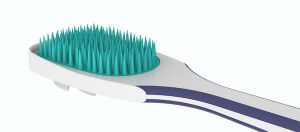
RyttPro Gum & Tongue Foam does the same job using a combination of sodium chlorite (stabilised chlorine dioxide), cetylpyridinium chloride (CPC) and zinc acetate.
Both products, in combination with the handy tongue cleaners, clean your tongue deep into the papillae whilst respecting your oral flora.
Once you’ve cleaned your tongue, it’s a good idea to rinse your mouth with water to remove the remains of tongue deposits from your mouth, and then rinse with a good mouthwash.
Read our tips for the specific factors that contribute to white plaque on the tongue.
Use pure toothpaste and mouthwash
If you’re going to treat your white tongue, it’s also a good idea to take a closer look at your basic oral hygiene. Pay particular attention to the ingredients of your toothpaste and mouthwash. The balance in your oral cavity isn’t served by all kinds of chemicals that are put in many toothpastes and mouthwashes. Think of the corrosive SLS (sodium lauryl sulfate) antiseptic agents that kill not only harmful but also beneficial bacteria and dubious plasticisers and dyes.
JuliBrite chewing toothpaste and JuliBrite mouthwash will help you effectively clean your white tongue.
What to do if you have thick white or yellowish tongue deposits?
For really stubborn cases of white or yellow deposits on the tongue, there’s Bergenfeld Tongue Serum. After brushing and scraping, give your clean an intensive finishing touch by sprinkling a few drops on your tongue. The combination of zinc and stabilised chlorine dioxide makes short work of harmful, odour-producing bacteria without disturbing the natural balance of your oral flora.
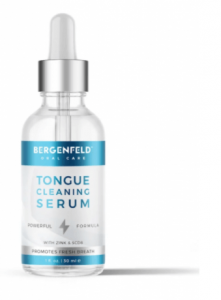
The benefits of a clean tongue
Cleaning your tongue will only have benefits. If you control the amount of bacteria on your tongue, you reduce the risk of gum disease, tonsil stones and caries (cavities). You’re also less likely to get bad breath or tonsil stones.
In addition, a healthier mouth has a beneficial effect on your overall health. While scientific studies now confirm this, cleaning your tongue is a daily routine in ancient Indian Ayurvedic medicine, with its primary focus on disease prevention. In Western medicine, the connection between oral health and general health has only recently received the necessary attention. American specialist Dr Nathan Bryan has even found evidence that a balanced oral flora slows down the ageing process.
When should you see a doctor or dentist?
With the right measures and resources, you can have a healthy pink tongue again within a few weeks. However, if this doesn’t happen, an underlying condition may be causing the white deposit, and it’s advisable to see your doctor. This is the same if you suffer from other symptoms in the mouth, such as a sore, burning or irritated tongue. Likewise, with wounds, sores or blisters in your mouth. Of course, you can also ask your dentist for advice.
Sources
Health Line: 5 Reasons to Scrape Your Tongue and How to Do It
NHS: Sore or white tongue

